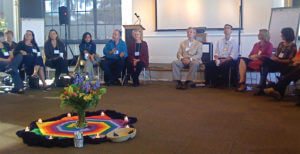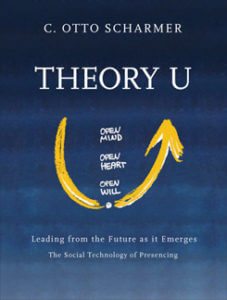Connecting With Source—Experiencing Theory “U”
Otto Scharmer ignited the Thought Leader Gathering at Fort Mason, San Francisco, today with his sharing about the application of Theory “U” to social transformation. Craig and Patricia Neal, the Heartland Circle sponsors, expanded the meeting to 110 people because of the interest in Otto’s work.
As a conversation starter, Otto’s job was to catalyze our thinking and conversations in wisdom circles and a larger group circle dialogue that followed. He really delivered. (He’s the third from the right.)

In a nutshell, Otto’s work is building off of his prior research around “presencing” and the importance of re-connecting personal intention, purpose and being to work in groups that are trying to address our times and future.
His new book, published by our local Berrett Khoehler, is called Theory U: Leading from the Future as It Emerges. What he talked about today was the practice of taking this set of ideas into practical application in the world of social change.
 Otto is a Senior Lecturer at the Massachusetts Institute of Technology and the founding chair of ELIAS (Emerging Leaders for Innovation Across Sectors), an initiative focused on developing profound system innovations for a more sustainable world. What is difficult to appreciate in a blog is what it feels like being with him.
Otto is a Senior Lecturer at the Massachusetts Institute of Technology and the founding chair of ELIAS (Emerging Leaders for Innovation Across Sectors), an initiative focused on developing profound system innovations for a more sustainable world. What is difficult to appreciate in a blog is what it feels like being with him.
I had the privilege of picking him up at his hotel early in the morning. His smile covered his entire face as he spotted me. He’s a tall man, and his body is grounded and present. I’d met him years ago at a Community Innovation Summit I was facilitating at MIT. I was struck all day by this man’s energy and humility. He is in genuine inquiry, aflame with the experience of what happens when groups reconnect with the missing ingredient in so many social processes – which is connecting with source, our inner intention and ground of being.
The content of the work he presented is accessible at http://presencing.com/ so I will only reflect on a bit of it here, and try and convey some of the feeling. It was his talk about levels of listening that struck a deep chord.
Otto got into this material experientially. He played a video clip of Placido Domingo performing No Puede Ser with a full orchestra. The clip begins showing Zubin Mehta leading the orchestra toward the aria, and then zooms in on Placido beginning to sing. His voice and competent control was apparent, and beautiful. But as the music swelled, Placido becomes completely absorbed in its sweep and feeling.
The video shows Mehta turning from the orchestra to watching Placido like a mother watching a newborn. He hangs on every nuance. There became no question that the music began singing Placido near the end, and Mehta became completely immersed in connecting the entire orchestra to every living note and nuance. At the very crescendo he actually steps back, and simply waits, letting the incandescent music become the center of it all.
The experience transcended rehearsal, went way beyond reading sheet music, and beyond control or ego-assertion. This was a portrait of people at the top of their game yielding to source, to the inner “singing” channeled through and being served by their competency.
Levels of Listening
In dialogue with all of us, Otto unpacked his observations about levels of listening.
Most of the time, Otto contended, we aren’t really listening, but make quick judgments based on our beliefs and prejudices. He calls this “downloading.” Most gatherings and meetings start here. The image I saw as he talked was of a person inside a cocoon of his or her own understandings of the world—our little “matrix.” I believe this is what psychologists would call our “egos.” “Downloading” involves reconfirming these old beliefs—it is Level I. I remembered meetings I’ve facilitated which felt like people were billiard balls bouncing off each others’ hardened shells of certainty. It’s what a lot of discussions and panels feel like.
Level II is when we shift to inquiry, or “factual listening” as Otto calls it. Here we notice differences. I imagined this like our ego-shells developing a dimple, an opening, and letting in some additional new information. This doesn’t necessarily change anything, just adds some new information, but it’s a start. I remembered a talk with my friend Bob Kolodny about Gestalt. This tradition represents people as being in a circular “shell.” Change happens when we crack these open to each other, and the drawing was of two circles with openings.
Level III is “empathetic listening.” This is where we actually step out of our shells and explore things from the point of view of others. It’s what metaphorically standing in the shoes of the person we are talking with. This is where we allow ourselves to feel what the other person might be feeling.
Level IV is “generative listening.” This is connecting to the future that is emerging at that moment, for indeed, the future creates itself in the collective moments all of us experience. My coach Vanda Marlow calls this listening for what is emerging in the space in between the persons communicating. This is what the conductor was doing at the end of the video.
Otto replayed the ending of the video. We all “got” it. We could see the conductor step into those levels, and finally connect with source.
The rest of our dialogue this day was transformed.
The wisdom circles of three that followed Otto’s talk held the question “What future is calling to each of us now: what is emerging in this moment?” and then for a second circle “What first steps are we willing to take to move toward that future?”
For me Otto breathed the life of research from the other coast into the work we’ve been doing with Process Theory and ignited my desire to join his larger conversation about social change from my experience, much as a musician would join an ensemble. His metaphors and stories about how we can reclaim wholeness are honed for the practical mind and enlivened my thinking.
I came to see that what we teach as the Four Flows of facilitation are these same four levels of listening, framed a different way. I could see that facilitation and managing the flow of “Operations” is about attending to the unconscious mechanisms we stand on – and in the mental realm this would be the “downloaded” certainties we use to steer by—the mechanistic thinking. While these aren’t “generative” levels, they are the foundations and mechanisms through which we live and need to be respected. But staying in our shells doesn’t create the future.
I could see that addressing the flow of “Information” is what Otto probably meant by listening at the “factual” level, the level of representational reality. Of course information involves interpretation and inference and connotation in addition to facts, and the patterns of visualization we use in graphic facilitation have additional levels of meaning. Is “listening for patterns and forms” a cousin of listening for facts?
And facilitating the flow of “Energy” at master levels seems hugely about “empathetic” listening and being able to stand in the shoes of all the different people involved in any process. In facilitation it’s also about feeling the dance of the group, the pacing, and the direction of movement. Accessing this kind of awareness involves actually feeling the flow with our own emotions and body. I think that qualifies as “empathy.”
And facilitating “Attention” is about accepting our inner life as being as real and generative as any of the other levels. The level of attention is the level of core consciousness in Process Theory, of what Otto calls “source.”
This ancient way of describing wholeness—of seeing our intuition, feeling, thinking, and sensing as one—and understanding how to apply this kind of “eco-systems” (as opposed to ego-systems) orientation to our times is what is calling to me. I want to be part of supporting the next generation of facilitators and consultants coming from this more integrative and comprehensive place. I felt deeply inspired and affirmed by what Otto was sharing.
I and the entire room erupted in gratitude and hopefulness as we experienced moving to this state of being together as a community this morning. Thank you Otto!!
Check out both his personal website, where he reflects on his visit to San Francisco, and Presencing.com to find out more about Theory U.


David Sibbet
May 11, 2009Hello David,
You raised the question: “the patterns of visualization we use in graphic facilitation have additional levels of meaning. Is “listening for patterns and forms” a cousin of listening for facts?” I would think Otto doesn’t mean to listen for facts only, but more listening to the bigger field… in this way I do think that ‘listening for patterns and forms’ is indeed part of what he tries to explain here. I think it is actually this skill – of seeing deeper patterns and forms – is a prerequisite to got to the other levels…
my two cents for now,
Ria
(Posted for Ria Beack @ ria.baeck@vitis-tct.be by David Sibbet)
Michael Bischoff
May 10, 2009Thank you for this eloquent summary of the event with Otto, and the connections to the “Four Flows of Facilitation.” I found your summaries of both of these things as quite helpful in conceptualizing my own work. I do facilitation and study of the “spirituality of organizations.”
I got to your post via the link on Otto’s blog. Glad to have found you!